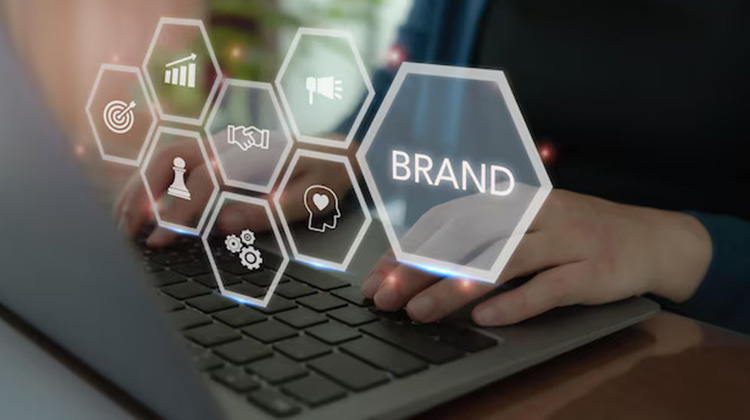Hand-crafted branding techniques have given way to automated alternatives that have increased access to advanced branding tools, allowing small companies to develop professional and cohesive brand identities with limited budget and effort.
Automated branding is achieved through innovative design combined with data analysis, artificial intelligence, and design technology. It offers businesses the capability of maintaining consistent messaging across platforms while responding quickly to market changes.
Understanding these automated tools and strategies is most importance for companies aiming to compete effectively in an expanding digital marketplace.
What is Automated Branding?
Automated branding is the use of technologically driven tools and platforms that simplify and improve the development, implementation, and management of strategies and assets for branding.
In contrast to traditional branding processes that heavily rely on the manual design process and subjective decisions, using algorithmic processes and data analysis to create brand elements with little human involvement.
The key elements of automated branding:
- AI-powered design generation designs logos and color schemes and other visual assets
- Automated content creation in advertising materials across all channels
- Brand consistency monitoring tools that guarantee unified messaging
- Data-driven personalization capabilities that allow branding to be adapted to certain segments of the audience
- Predictive analytics to improve the brand’s efficiency
These technologies work together to decrease the time and money required to manage a brand effectively while also improving the brand consistency and its market-responsiveness.
Also read: How to Generate New Product Ideas
Key Benefits of Implementing Automated Branding
1. Time and Resource Efficiency
One of the greatest benefits of using automated branding lies in the drastic reduction in the time needed to create and implement branding strategies. Things that used to take weeks are now completed in just a few hours, or even minutes, allowing marketers to concentrate on strategic plans instead of the details of execution.
2. Consistency Across Touchpoints
Automated systems can ensure an exact consistency across all brand points of contact, from web design to posts on social networks to marketing emails. This consistency helps build the brand’s recognition and creates confidence with the audience.
3. Data-Driven Decision Making
Automated branding systems monitor and measure brand performance continuously, enabling businesses to make adjustments based on actual audience feedback instead of guesses or intuition alone.
4. Scalability for Growing Businesses
As companies expand their operations to new platforms or markets, efficient branding tools can scale with the same ease, without having to increase personnel or resources. This allows for scalable branding available to businesses at all stages.
5. Cost Reduction
The financial benefit of reducing the time spent on branding can be significant, with businesses saving up to 30 per cent compared to traditional branding methods conducted by agencies.
5 Popular Automated Branding Tools
1. BrandForge AI
The company was founded in 2023. BrandForge AI has quickly become an industry leader thanks to its tools for automating branding and identity creation. The platform uses advanced neural networks to produce full brand packages, which include logos and typography, color schemes, and style guides, based on simple business descriptions and target audience data.
2. Persona Suite
Specializing in adapting brands to the needs of an audience, Persona Suite allows companies to automatically adapt their brand for various demographic groups while preserving the integrity of their brand. The most notable feature is its capability to create customized marketing materials on a large scale.
3. BrandSync Pro
Aimed at omnichannel consistency, BrandSync Pro monitors brand presentation across social media, websites, advertising, and physical items, automatically highlighting any inconsistencies and recommending corrections.
4. ElementAI Designer
The platform is gaining acclaim due to its unrivaled ability to design, produce not only basic brand assets but also sophisticated visual elements such as custom logos, animated illustrations, and interactive experiences for brands.
5. ContentGenius
Although it’s primarily a creation system, ContentGenius has become essential in the automated branding because of its capacity to create writing that is aligned with brand standards, ranging that ranges from tweets on social networks to complete marketing campaigns that have a remarkable human-like quality.
Also read: What Is White Label Link Building & How to Choose the Right Service
Future of Automated Branding
Hyper-Personalization
The next frontier of automated branding will go beyond demographic segments and focus on individual-level customization, where brand experiences can be tailored to specific users’ behavior and preferences in real time.
Ambient Branding
The latest technologies allow for an automated brand presence in physical spaces through IoT devices such as augmented reality, smart surfaces that display dynamically branded elements.
Emotional Intelligence
Advanced sentiment analysis allows brands to automate their branding processes to recognize and react to emotional contexts, changing tone and message to suit.
Blockchain-Verified Brand Assets
Distributed ledger technology is being incorporated with automated branding, resulting in authentic, tamper-proof brand assets that can thwart counterfeiting and unauthorised use.
Collaborative AI-Human Design
At present, rather than replacing human designers entirely with AI technology solutions, collaborative interfaces have emerged in which artificial intelligence provides options that human designers can modify or combine for enhanced designs.
Conclusion
Automated branding technologies have revolutionized how companies create and sustain their brand image, offering unmatched effectiveness, consistency, and data-driven optimization across companies of all sizes. By 2025, these tools will have become market-leading.
As your company builds or expands an automated branding system, keep this in mind: its purpose should be to strengthen rather than define your brand’s personality and mission.















Leave a comment